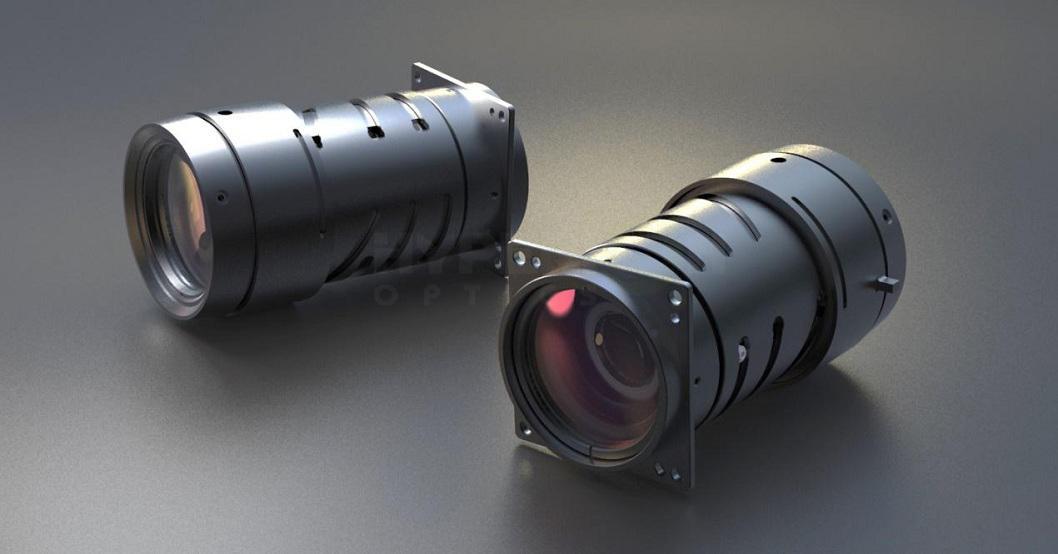Industrial lens is an important component of the machine vision acquisition system. the telephoto zoom lens is a relatively young member of the lens family and is becoming the most kind-hearted star with its unique performance. But also because the telephoto zoom lens is introduced in a relatively short time, many of these characteristics is not widely known. In this paper, we introduce the telephoto zoom lens from the application of the telephoto zoom lens, the selection method, and the application scope. and we give a comprehensive analyzing and uncover secret light experience in the telecentric system.

Part 1: principle description of telephoto zoom lens
First of all, let's start with a few questions about the
telephoto zoom lens. First, the general lens in the imaging process, when the working distance is changed, the image size will change accordingly, the result is the same focal length of the lens corresponding to the different object distance, there will be different magnification. this phenomenon is similar to the fact, everything looks small in the distance and big on the contrary, in human visual system. This problem can be neglected or even exploited in some applications, but this feature can be a major hindrance when our vision system is used to perform precise measurement tasks. Second, the ordinary lens has a certain range of depth of field, when the measured object depth range out of the lens, the image will become blurred, unable to focus clearly. Therefore, the designers design the focusing ring in common lens. When the distance changes, it will adjust the focus to see the region of interest. The problem is, if the object beyond a certain range in itself, the camera has no way to see the end to end, other ways must be adopted to solve. Third, with the imaging chip resolution improvement, the user requirements on the measurement accuracy is more and more strict. Subject to the principle of ordinary lens optical imaging, the best lens only reaches about 10um. The field of vision detection needs more accurate imaging products.
Double telephoto zoom lenses are born to solve these problems. For the double telephoto zoom lenses, parallel by place an aperture stop in the middle position of the optical system, the main light will pass through the center point of the aperture, and the main light will be parallel to the optical axis to enter the lens. The parallel light to ensure sufficient large depth of field, the parallel light from the lens ensure that the working distance is changed greatly in the depth range, the height of the imaging magnification is not change.
Part 2: Application range of double telephoto zoom lenses
what circumstances should we use telephoto zoom lenses under? According to the author's many years experience in machine vision product selection, he give readers some reference, that is , double telephoto zoom lenses suggested to be chooses under the following situations:
1) when the thickness of the detected object is large enough and have more than one plane.need to be detected, such as food boxes, beverage bottles, etc.
2) when the position of the object to be measured is uncertain, it may be at an angle with the lens.
3) when the object to be detected is jumped up and down, such as the production line vibration causing changes in work distance.
4) when an object is measured with apertures or three-dimensional objects.
5) when the low distortion rate is required and the image effect luminance is almost identical.
6) when the defects need to be detected in the same direction, only parallel lighting can be detected.
7) when the inspection accuracy is exceeded, such ad the tolerance is 1um.
Part 3: the selection method of telephoto zoom lens
The selection method telephoto zoom lens is similar with the ordinary
optical system in the camera, several points need to pay attention as follows:
Compatible CCD target surface dimensions. This is similar to the choice of ordinary lenses, requiring telephoto zoom lens compatible CCD target surface is greater than or equal to the matching camera target surface, otherwise it will cause waste of resolution.
Interface type. At present, the telephoto zoom lens provides the interface type similar to the ordinary lens, has C mouth, F mouth and so on, as long as the matching can be used.
Magnification, or imaging range. When magnification is determined with the CCD target surface, the imaging range is determined, and vice verse.
Operating distance. Generally, at above three points determined, the operating distance has been controlled within a range, which is determined by its imaging light path. It is important to pay attention to whether the work distance meets the actual requirement. When the telecentric system is detected, we suggest that the lens be selected first, and other mechanical structures are designed according to the working distance.
Depth of field. With the first few conditions meet, the larger the depth of field, the better the optical characteristics of telecentric system, It can be used as reference in model selection.

 Call us on:
Call us on:  Email us:
Email us:  R&D Center: Aoti Street #68 Building 4A 405 International R&D park, Nanjing
R&D Center: Aoti Street #68 Building 4A 405 International R&D park, Nanjing









 English
English  cn
cn  de
de  es
es  fr
fr 


